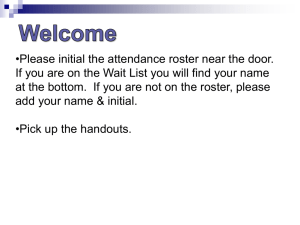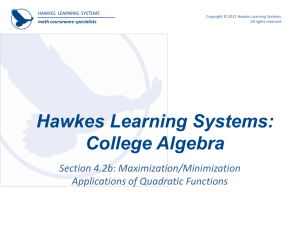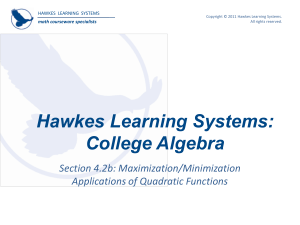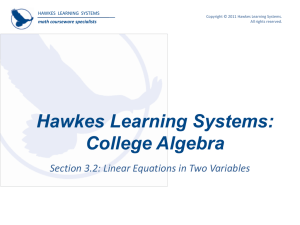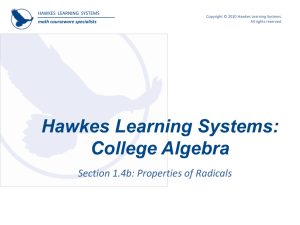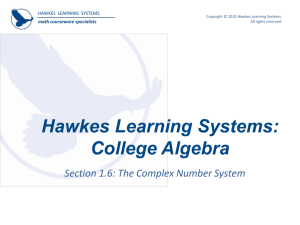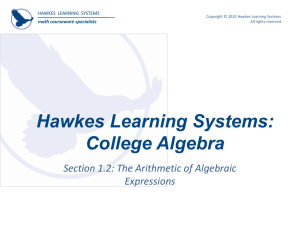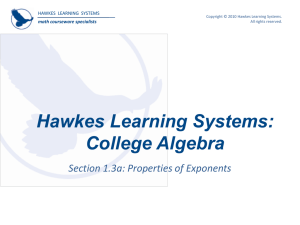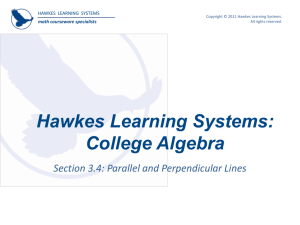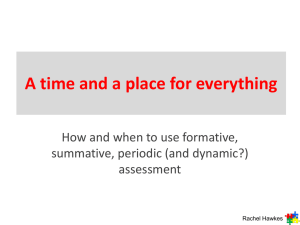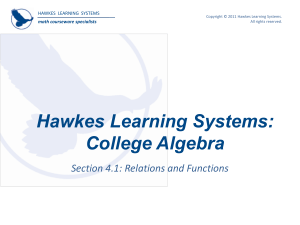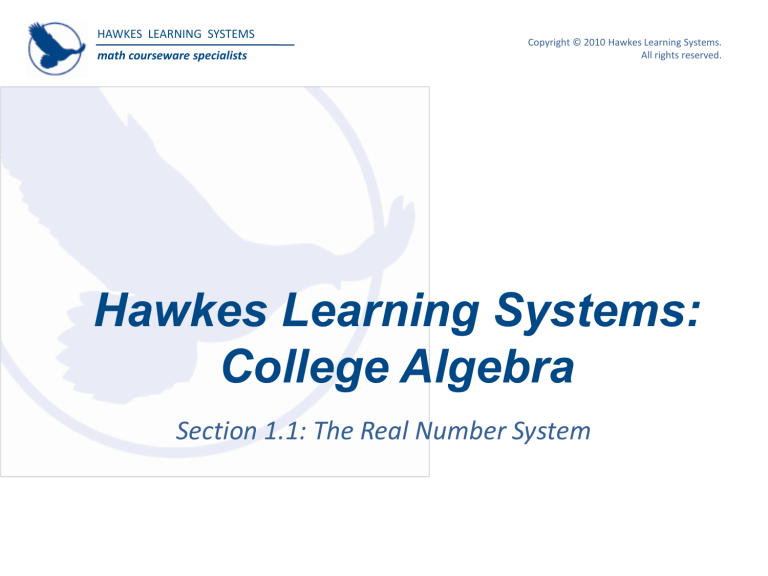
HAWKES LEARNING SYSTEMS
math courseware specialists
Copyright © 2010 Hawkes Learning Systems.
All rights reserved.
Hawkes Learning Systems:
College Algebra
Section 1.1: The Real Number System
HAWKES LEARNING SYSTEMS
Copyright © 2010 Hawkes Learning Systems.
All rights reserved.
math courseware specialists
Objectives
o Common subsets of real numbers.
o The real number line.
o Order on the real number line.
o Set-builder notation and interval notation.
o Absolute value and distance on the real number line.
o Working with repeating decimals.
HAWKES LEARNING SYSTEMS
math courseware specialists
Copyright © 2010 Hawkes Learning Systems.
All rights reserved.
Common Subsets of Real Numbers (cont.)
o The Natural (or Counting) Numbers:
The set of counting numbers greater than or equal to 1.
{1,2,3,4,5,...}
o The Whole Numbers:
The set of Natural numbers and 0.
W={0,1,2,3,4,5,...}
=
o The Integers:
The set of natural numbers, their negatives, and 0.
{... 4, 3, 2, 1,0,1,2,3,4,...}
HAWKES LEARNING SYSTEMS
math courseware specialists
Copyright © 2010 Hawkes Learning Systems.
All rights reserved.
Common Subsets of Real Numbers
o The Rational Numbers: The set of ratios of integers, . Any
p
rational number can be written in the form , where p and q
q
are both integers and q 0. Rational numbers either terminate or
repeat patterns of digits past some point.
Ex: 12,
3
29
, 3,
4
8
o The Irrational Numbers: Every real number that is not rational. In
decimal form, irrational numbers are non-terminating and nonrepeating.
Ex: , 5
o The Real Numbers: Every set above is a subset of the set of real
numbers, which is denoted . Every real number is either rational
or irrational and no real number is both.
, the whole numbers, ,
, the irrational numbers
HAWKES LEARNING SYSTEMS
Copyright © 2010 Hawkes Learning Systems.
All rights reserved.
math courseware specialists
Common Subsets of Real Numbers
Real Numbers ( )
Rational Numbers ( )
Decimal term either terminates
or repeats
Integers ( )
…,-3,-2,-1,0,1,2,3,…
Whole Numbers
0,1,2,3…
Natural Numbers
( )
1,2,3…
Irrational Numbers
Decimal form is
non-terminating and
non-repeating.
HAWKES LEARNING SYSTEMS
Copyright © 2010 Hawkes Learning Systems.
All rights reserved.
math courseware specialists
Example 1: Common Subsets of Real Numbers
Consider the set
5
S {13, 4.5, , 0, 3,1.9537, 4 , ,1012 }
3
Natural
Whole Integers
Numbers Numbers
4, 1012 0, 4 , 1012 13, 0
Rational
Numbers
Irrational
Real
Numbers Numbers
13, 4.5
5
3,
13, 4.5, ,
12
5
3
4 , 10
,0
3
0, 1.9537, 4
3 ,1.9537
1012
4 , ,1012
HAWKES LEARNING SYSTEMS
Copyright © 2010 Hawkes Learning Systems.
All rights reserved.
math courseware specialists
The Real Number Line
The real number line is a depiction of the set of real
numbers as a horizontal line. The real number
corresponding to a given point is called the coordinate of
that point. The point for the number 0 is called the origin.
Points to the right of the origin represent positive numbers
and points to the left of the origin represent negative
numbers.
Ex: Plot the following numbers on the real number line:
0, , 5, 2, 1
|
|
|
|
|
Negative Numbers
| |
1 0
|
|
|
|
|
2
Positive Numbers
|
5
HAWKES LEARNING SYSTEMS
Copyright © 2010 Hawkes Learning Systems.
All rights reserved.
math courseware specialists
Example 2: The Real Number Line
a. Plot the numbers 101, 106, and 107:
|
|
|
|
|
|
101
|
|
|
|
|
106 107
1
3 1
b. Plot the numbers , , and
4
4 2
|
1
|
|
3 1
4 2
|
|
|
0
1
4
|
|
|
1
HAWKES LEARNING SYSTEMS
math courseware specialists
Copyright © 2010 Hawkes Learning Systems.
All rights reserved.
Order on the Real Number Line
Symbol
Read
ab
“a is less than b”
ab
ba
ba
Meaning
a lies to the left of b on the
number line.
“a is less than or equal a lies to the left of b or is equal
to b”
to b.
“b is greater than a” b lies to the right of a on the
number line.
“b is greater than or b lies to the right of a or is equal
to a.
equal to a”
The two symbols < and > are called strict inequality signs, while
the symbols ≤ and ≥ are non-strict inequality signs.
HAWKES LEARNING SYSTEMS
Copyright © 2010 Hawkes Learning Systems.
All rights reserved.
math courseware specialists
Example 3: Order on the Real Number Line
What can we say about the following relationship?
|
|
|
|
5
|
8
a. 5 lies to the left of 8 .
b. 5 8 , or 5 is strictly less than 8 .
c. 5 8 , or 5 is less than or equal to 8 .
d. 8 5 , or 8 is strictly greater than 5 .
e. 8 5 , or 8 is greater than or equal to 5 .
|
|
HAWKES LEARNING SYSTEMS
math courseware specialists
Copyright © 2010 Hawkes Learning Systems.
All rights reserved.
Example 4: Order on the Real Number Line
a. The statement “a is less than or equal to b + c” is
written: a b c .
b. The negation of the statement a ≤ b is a b .
Why is this true? a ≤ b means that “a is less than or equal to b.” The
negation of a statement is to say that the statement is not true. So, if
a is NOT less than or equal to b then a must be greater than b and a
cannot be equal to b. Thus, a must be strictly greater than b.
c. If a ≤ b and a ≥ b then it must be the case that a b .
Why is this true? Consider each case on a real number line.
Where can you place a and b in the
a≤b
| | | | | | |
a ab b
second case so that the first case holds
a≥b
| | | | | | |
b ab a
true? You should notice that this is
impossible unless you make a = b.
HAWKES LEARNING SYSTEMS
math courseware specialists
Copyright © 2010 Hawkes Learning Systems.
All rights reserved.
Set-Builder Notation and Interval Notation
o Set-builder notation is a general method of
h
describing the elements that belong to a given set.
o The notation {x|x has property P} is used to describe
a set of real numbers, all of which have the property
P. This can be read “the set of all real numbers x
having property P.”
o Interval notation is a way of describing certain
subsets of the real line.
HAWKES LEARNING SYSTEMS
math courseware specialists
Copyright © 2010 Hawkes Learning Systems.
All rights reserved.
Example 5: Set-builder Notation and Interval
Notation
What sets of real numbers do the following properties
describe?
a. {x|x is an even integer}
= {…,-4,-2,0,2,4…}
This set could also be described as {2n|n
is an integer} since every even integer is
a multiple of 2.
b. {x|x is an integer such that -4 ≤ x <1}
= {-4,-3,-2,-1,0}
c. {x|x > 2 and x ≤ -5}
= { } or
These symbols denote the empty set.
This property describes the empty set
because no real numbers satisfy it.
HAWKES LEARNING SYSTEMS
math courseware specialists
Copyright © 2010 Hawkes Learning Systems.
All rights reserved.
Set-builder Notation and Interval Notation
o Sets that consist of all real numbers bounded by two
endpoints are called intervals. Intervals can also
extend indefinitely in either direction.
o Intervals of the form (a,b) are called open intervals.
o Intervals of the form [a,b] are called closed intervals.
o The intervals (a,b] and [a,b) are called half-open or
half-closed.
o The symbols and indicate that the interval
extends in the left and right directions, respectively.
HAWKES LEARNING SYSTEMS
math courseware specialists
Copyright © 2010 Hawkes Learning Systems.
All rights reserved.
Set-builder Notation and Interval Notation
Interval
Notation
Set-Builder
Notation
Meaning
(a,b)
{x|a < x < b}
All real numbers strictly between a and b.
[a,b]
{x|a ≤ x ≤ b}
All real numbers between a and b,
including both a and b.
(a,b]
{x|a < x ≤ b}
All real numbers between a and b,
including b but not a.
( ,b)
{x|x < b}
All real numbers less than b.
[a, ]
{x|x ≥ a}
All real numbers greater than or equal to a.
HAWKES LEARNING SYSTEMS
Copyright © 2010 Hawkes Learning Systems.
All rights reserved.
math courseware specialists
Example 5: Set-builder Notation and Interval
Notation
Describe each of the following properties using the chart below:
a. All real numbers strictly between -5 and 8.
b. All real numbers greater than or equal to 2.
c. All real numbers between -10 and 3, including 3 but not -10.
d. The entire set of real numbers.
a.
b.
c.
d.
Interval
Notation
Set-builder
Notation
5,8
2,
10,3
,
x | 5 x 8
x | x 2
x | 10 x 3
x | x
Interval is
______ at the
left endpoint
Interval is
______ at the
right endpoint
open
open
closed
open
open
closed
open
open
HAWKES LEARNING SYSTEMS
math courseware specialists
Copyright © 2010 Hawkes Learning Systems.
All rights reserved.
Absolute Value and Distance on the Real
Number Line
oThe absolute value of a real number a, denoted as |a|, is
defined by:
a if a 0
a
a if a 0
oThe absolute value of a number is also referred to as its
magnitude; it is the non-negative number corresponding
to its distance from the origin.
oGiven two real numbers, the distance between them is
defined to be |a−b|. In particular, the distance between a
and 0 is |a−0| or just |a|.
HAWKES LEARNING SYSTEMS
Copyright © 2010 Hawkes Learning Systems.
All rights reserved.
math courseware specialists
Absolute Value and Distance on the Real
Number Line
Properties of Absolute Value
For all real numbers a and b:
1. a 0
a
a
5. , b 0
b
b
2. a a
6. a b a b
3. a a
7. a b b a
4. ab a b
(This is called the
triangle inequality
because it is a reflection
of the fact that one side
of a triangle is never
longer than the sum of
the other two sides.)
HAWKES LEARNING SYSTEMS
Copyright © 2010 Hawkes Learning Systems.
All rights reserved.
math courseware specialists
Example 6: Absolute Value and Distance on
the Real Number Line
Simplify the following expressions using your
knowledge of absolute values:
a. 21 7 7 21 14
14 14 14. 21 and 7 are 14 units apart.
b.
Both and – are units from 0.
c. 3 3
How does this compare to (3) ?
d. 11 3 11 3
11 is greater than 3, so this must be a positive
number.
11 is less than 13, so this expression must be
negative. So, its absolute value is 11 13 .
e. 11 13 13 11
f. 5 5 5
8
8
8
Note the properties of absolute value.
HAWKES LEARNING SYSTEMS
math courseware specialists
Copyright © 2010 Hawkes Learning Systems.
All rights reserved.
Working with Repeating Decimals
A rational number that appears with a repeating pattern of digits
can be written as a ratio of integers by following the procedure
outlined below:
Suppose we wish to write 1.4568 as a ratio of integers.
45
We know that 1.4568 1
0.0068.
100
Now, let x 0.0068
68
100 x 0.68
99 x
100
100 x 0.68 0.0068
68
17
x
Substitute x 0.0068
9900 2475
100 x 0.68 x
So, together we have
45
17
14423
99 x 0.68
1.4568 1
100 2475 9900

